Evolutionary gain of function for the ER membrane protein Sec62 from yeast to humans
- PMID: 20071467
- PMCID: PMC2828957
- DOI: 10.1091/mbc.e09-08-0730
Evolutionary gain of function for the ER membrane protein Sec62 from yeast to humans
Abstract
Because of similarity to their yeast orthologues, the two membrane proteins of the human endoplasmic reticulum (ER) Sec62 and Sec63 are expected to play a role in protein biogenesis in the ER. We characterized interactions between these two proteins as well as the putative interaction of Sec62 with ribosomes. These data provide further evidence for evolutionary conservation of Sec62/Sec63 interaction. In addition, they indicate that in the course of evolution Sec62 of vertebrates has gained an additional function, the ability to interact with the ribosomal tunnel exit and, therefore, to support cotranslational mechanisms such as protein transport into the ER. This view is supported by the observation that Sec62 is associated with ribosomes in human cells. Thus, the human Sec62/Sec63 complex and the human ER membrane protein ERj1 are similar in providing binding sites for BiP in the ER-lumen and binding sites for ribosomes in the cytosol. We propose that these two systems provide similar chaperone functions with respect to different precursor proteins.
Figures
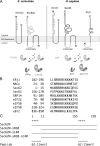
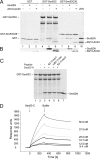
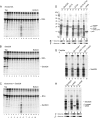
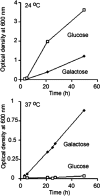
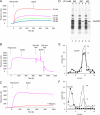
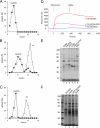

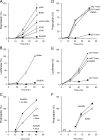
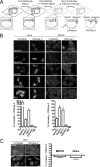
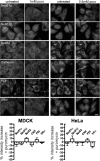
Similar articles
-
Emerging View on the Molecular Functions of Sec62 and Sec63 in Protein Translocation.Int J Mol Sci. 2021 Nov 25;22(23):12757. doi: 10.3390/ijms222312757. Int J Mol Sci. 2021. PMID: 34884562 Free PMC article. Review.
-
Hph1 and Hph2 are novel components of the Sec63/Sec62 posttranslational translocation complex that aid in vacuolar proton ATPase biogenesis.Eukaryot Cell. 2011 Jan;10(1):63-71. doi: 10.1128/EC.00241-10. Epub 2010 Nov 19. Eukaryot Cell. 2011. PMID: 21097665 Free PMC article.
-
Identification of signal peptide features for substrate specificity in human Sec62/Sec63-dependent ER protein import.FEBS J. 2020 Nov;287(21):4612-4640. doi: 10.1111/febs.15274. Epub 2020 Mar 20. FEBS J. 2020. PMID: 32133789
-
Cotranslational Targeting and Posttranslational Translocation can Cooperate in Spc3 Topogenesis.J Mol Biol. 2021 Sep 3;433(18):167109. doi: 10.1016/j.jmb.2021.167109. Epub 2021 Jun 18. J Mol Biol. 2021. PMID: 34153287
-
The protein translocation apparatus of the rough endoplasmic reticulum, its associated proteins, and the mechanism of translocation.Curr Opin Cell Biol. 1991 Aug;3(4):580-4. doi: 10.1016/0955-0674(91)90026-u. Curr Opin Cell Biol. 1991. PMID: 1772653 Review.
Cited by
-
Mutation of sec63 in zebrafish causes defects in myelinated axons and liver pathology.Dis Model Mech. 2013 Jan;6(1):135-45. doi: 10.1242/dmm.009217. Epub 2012 Aug 3. Dis Model Mech. 2013. PMID: 22864019 Free PMC article.
-
Dual topology of co-chaperones at the membrane of the endoplasmic reticulum.Cell Death Discov. 2021 Aug 5;7(1):203. doi: 10.1038/s41420-021-00594-x. Cell Death Discov. 2021. PMID: 34354047 Free PMC article. Review.
-
AtTPR7 as part of the Arabidopsis Sec post-translocon.Plant Signal Behav. 2013 Aug;8(8):e25286. doi: 10.4161/psb.25286. Epub 2013 Jun 11. Plant Signal Behav. 2013. PMID: 23759546 Free PMC article.
-
Regulation of Translation, Translocation, and Degradation of Proteins at the Membrane of the Endoplasmic Reticulum.Int J Mol Sci. 2022 May 17;23(10):5576. doi: 10.3390/ijms23105576. Int J Mol Sci. 2022. PMID: 35628387 Free PMC article. Review.
-
Mammalian SRP receptor switches the Sec61 translocase from Sec62 to SRP-dependent translocation.Nat Commun. 2015 Dec 4;6:10133. doi: 10.1038/ncomms10133. Nat Commun. 2015. PMID: 26634806 Free PMC article.
References
-
- Beckmann R., Spahn C.M.T., Eswar N., Helmers J., Penczek P., Sali A., Frank J., Blobel G. Architecture of the protein-conducting channel associated with the translating 80S ribosome. Cell. 2001;107:361–372. - PubMed
-
- Blau M., Mullapudi S., Becker T., Dudek J., Zimmermann R., Penczek P., Beckmann R. ERj1p uses a universal ribosomal adaptor site to coordinate the 80S ribosome at the membrane. Nat. Struct. Mol. Biol. 2005;12:1015–1016. - PubMed
-
- Davila S., et al. Mutations in SEC63 cause autosomal dominant polycystic liver disease. Nat. Genet. 2004;36:575–577. - PubMed
Publication types
MeSH terms
Substances
Grants and funding
LinkOut - more resources
Full Text Sources
Other Literature Sources
Molecular Biology Databases

